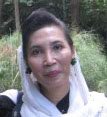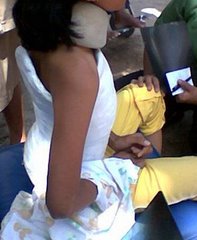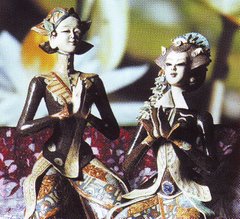Bonnie L Brandes, MEd
Cerebral palsy (CP) is a postural and movement disorder caused by brain malformation or injury in the prenatal, perinatal (around birth), or
postnatal time period. The illness is non-progressive within the brain, but musculoskeletal and other tissues affected by the condition can
continue to weaken.
n the United States CP is the major disability affecting children’s functional development, with a prevalence of 1.5 to 2.0 cases per 1000. The
affected child is often unable to control motor functions normally. The illness is also associated with cognitive impairment and other
developmental disabilities. The child may have difficulties speaking, seeing, hearing, learning, and becoming independent depending on the
location and severity of the brain damage.
Many patients have normal intelligence, but communication skills are diminished because of speech and motor difficulties. It is therefore most
important not to underestimate the child’s intellect; he or she should be given every opportunity to learn. Lower life expectancy is related to
severe disabilities, such as mental retardation, necessity for tube feedings, and seizures, but otherwise, normal life expectancy may be expected.
Although a definitive cure does not yet exist, therapy, education, and technology can improve the child’s functioning and quality of life. The last
section of this paper reports on treatment successes using low level laser therapy.
Risk Factors
In approximately 25% to 40% of children with CP, birth was at less than 37 weeks gestation. Those with birth weight less than 1500 g (3.3
pounds) are at the highest risk. Damage to the periventricular white matter of the brain is the most common cause of CP in preterm infants. In
more than 30% of children with CP, etiology or risk factors are unknown.
Types of CP
CP can be classified according to the dominant motor characteristics—spastic, hypotonic, athetotic, dystonic, and ataxic, or by the pattern of limb
damage—monoplegia, diplegia, triplegia, hemiplegia, or quadriplegia.
Another way to classify the disease is by the two physiological types, pyramidal (spastic) and extra pyramidal (nonspastic). Pyramidal/spastic CP
is caused by damage in the corticospinal pathways of the brain. It accounts for 70% to 80% of all cases. In approximately 30% of cases, there is
cognitive impairment. The most conspicuous feature is increased muscle tone; other features include hyperreflexia, clonus (involuntary muscular
contractions), and persistent primitive reflexes, including Babinski.
Extrapyramidal (nonspastic) CP is caused by nerve damage outside of the pyramidal tracts in the basal ganglia or the cerebellum. There are two
subtypes, dyskinetic and ataxic. The disability is global, with inadequate regulation of muscle tone, poor control over posture, and abnormal
coordination.
Hypotonic CP, characterized by motor delays, is classified as CP only when myopathy and neuropathy have been ruled out as causes. Infants
with this CP have a marked decrease in muscle tone and a significant delay in motor milestones. Problems in feeding result from weak facial and
mouth muscles.
There are persistent primitive reflex patterns and hyperreflexia.
Different combinations of CP types are seen in some children.
Diagnosis of CP
Diagnosis is made mainly from clinical observation. Major signs include delayed motor milestones, abnormal neurological exam, persistence of
primitive reflexes, and abnormal postural reactions. No single abnormality is conclusive. Generally, the more severely ill child is diagnosed by the
age of six months, or later when symptoms are milder. The earlier the diagnosis, the sooner the child’s abnormal behavior can be understood by
the parents, allowing time to plan for long-term management.
Brain damage documented by cranial ultrasound, CAT scan, or MRI can facilitate diagnosis. When a child with identified lesions shows delayed
motor milestones, abnormal muscle tone, and retained primitive reflexes, an earlier diagnosis can be made. A series of examinations noting
progression is also useful in diagnosis.
Persistence of primitive reflexes is a hallmark of the condition. Most primitive reflexes are integrated within the first four to eight months of life, but
they may persist into adulthood in CP. Persistence of these reflexes adversely affects muscle tone and limb position, preventing the development
of voluntary motor movements. There may also be failure to develop protective reflexes such as parachute response or asymmetrical response.
In the neurological examination, the following are significant: abnormal muscle tone, weakness, deep tendon reflexes, clonus persisting beyond
12 months, and side to side asymmetries in muscle tone or functional abilities.
Prognosis
Predicting future abilities or disabilities is difficult at the time of diagnosis, leading to a “wait-and-see” approach.
Prediction of Ambulation:
How can the child’s ambulation potential be predicted? Sala and Grant present three categories of predictors: primitive reflexes and postural
reactions, gross motor skills, and type of CP. (1)
Persistence in these primitive reflexes by two years of age—asymmetrical tonic neck reflex (ATNR), symmetrical tonic neck reflex (STNR), Moro
reflex, tonic labyrinthine reflex, and to a lesser degree, positive supporting reflex—have been shown to be associated with inability to ambulate.
The same is true of abnormal postural reactions of foot placement and parachute reactions. (1)
In the category of gross motor skills, Jones and Morgan (2) report the following: In all types of CP, independent sitting by age 2 was found to be
reliably predictive for eventual walking. Achievement of head balance before nine months, ability to put weight on hands while prone and rolling
from supine to prone by 18 months, and motor control of crawling by 30 months were also found to be predictors of ambulation.
For type of CP as a predictor, Sala and Grant report the following: spastic hemiplegia, very good prognosis; spastic diplegia, good prognosis
(over 85%); spastic quadriplegia, much less favorable, with a wide range outcomes. (1)
Classifications of Severity:
In defining severity, a 5-level Gross Motor Function Measure has been developed by Rosenbaum, et al. (3) In Level 1 the patient walks without
restrictions (some limitations in advanced gross motor skills); Level II, able to walk without devices; Level III: able to walk with mobility devices;
Level IV, self mobility with limitations (power mobility); Level V, self mobility severely limited, even with technology. Parents often seek categories
of mild, moderate, and severe. Jones et al gives the following rule of thumb: mild – walking without assistance; moderate – requires medications,
bracing, and adaptive equipment to ambulate; severe – only mobile in a wheelchair. (2)
Success of LLLT (Low Level Laser Therapy) in Treating CP
Several clinical studies have been published concerning treatment of CP by soft laser, including application to acupuncture points on the scalp.
Scalp acupuncture was developed in China by Dr. Jiao Shunfa in 1971. Combining acupuncture in clinical practice and modern anatomy and
physiology, Dr. Shunfa developed a methodology based on 16 scalp areas. Studies have shown that scalp acupuncture increases cerebral
blood flow. (4) The World Health Organization reviewed and standardized scalp acupuncture in 1984.
In an early prospective study in 2001 - 2002, Fadaie and Khan performed a seven month treatment program of children with cerebral palsy and
other brain damage, applying laser therapy at scalp acupuncture points. (5) Seventeen boys and 12 girls, aged 5 months through 11 years,
were treated at the Fazal Hospital in Lahore, Pakistan.
Results showed significant improvement:
16 with brain damage and spasticity: six recovered fully, six had mild to moderate improvement, four had no improvement.
6 with brain damage and flaccidity or normal musculature: all six showed improved muscle function.
29 with brain damage and speech disorders: one showed great improvement; seven showed mild to moderate improvement; 21 showed little
improvement.
4 with brain damage and epileptic fits: Two showed improvement, but frequency of fits increased. It was concluded that treatment with laser
acupuncture should be continued, but with longer inter-session intervals and use of anti-epileptic medication. In a subsequent study in 2003 –
2004, no increase in epileptic fits was noted. (6)
10 children with cortical blindness: four recovered completely.
5 with impaired hearing or deafness: all five improved.
2 with autism: autism improved little, although other mental faculties improved.
Best results were noted in children less than two years old; the second best results were in ages less than 5. In ages 5 through 10, results were
poor. For the one subject 11 years old, results were very poor.
In a larger study conducted on children with cerebral palsy in 2003 through 2006 at Children’s Hospital in Lahore, Pakistan, 250 children were
treated with Aculaser therapy directed at acupuncture sites, including sites on the skull. (7) Aculaser therapy consists primarily of low level laser
therapy, acupuncture, and physical therapy. A minimum of 15 treatments for a minimum of six weeks was given to each of the children, who were
classified according to type of CP.
Results showed significant improvement:
171 children with spasticity and stiffness: 147 showed marked improvement (87% success).
126 with epileptic fits: 91 showed a significant reduction in intensity, frequency, and duration of fits (72% success).
48 children with cortical blindness: 30 showed improvement (63% success).
105 with hearing difficulty: 63 showed marked improvement (60% success).
190 with speech disorders, 122 showed improvement (64% success).
96 with hemiplegia, 71 showed improvement in movement, tone, and power (74% success).
76 with quadriplegia, 52 showed improvement in gross and fine motor functions (69% success).
58 with paraplegia of lower limbs, 44 showed improvement in weight bearing, standing, and movement (76% success).
Children given a break in treatment for one month to one year did not show any reversal of symptoms.
As in the earlier study, best results were noted in children less than two years old; the second best results were in ages less than 5.
Similar successful results were demonstrated by the same group in another study using Aculaser therapy. (6) For the scalp, a red diode laser
was used with a wavelength 650 nm, power of 5mW, and duration of 30 - 45 seconds. For body and auricular points, a HeNe laser was used with
a wavelength 632.8, power of 30 mW, and duration of 15 seconds.
It is concluded from these studies that the low level laser can be a valuable therapy in reducing the degree of disability in persons with CP.
Success Story:
Annie, age 6-1/2 years, received three Quantum Reflex Integration sessions during a three month period. The sessions included using the
Quantum Wave Laser with the "Unwinding" protocol (developed by Paul Weisbart), QRI laser acu-points, and QRI laser reflex integration
techniques for active primary reflexes. Primary reflexes that were addressed: Moro, Babinski, Leg Cross Flexion, Spinal Galant, Spinal Perez,
Hands Grasping, Automatic Gait, and Tonic Labyrinthine.
Annie's mother stimulated QRI acu-points manually as a home program times 3 - 4 times a week for approximately 30-40 minutes each session.
Mother does not have access to a laser between therapist sessions.
After the first session, Mom reported that Annie's ability to jump on a mini trampoline improved from 0 inches to 3 inches, with some assistance
for balance. Also after the first session, Annie's balance and endurance in walking without braces improved.
After three sessions, Mother reports that Annie has more confidence and better balance, and has met her first goal of jumping off the ground
independently. She has continued to improve in mobility and strength as demonstrated by her ability to walk around the yard without braces and
move a chair from one area to another. She now is able to pump her legs while swinging on a swing set, walk up steps of 4" without assistance
or holding on to a rail, and has increased the length of her stride.
Previous therapies include Physical Therapy and Occupational Therapy; current therapies and programs include QRI, Physical Therapy and
Occupational Therapy.
QRI Home Training Programs allow parents and therapists to successfully give their children possibilities, options, and successful
outcomes using soft lasers and reflex integration.
References:
1. Sala DA, Grant AD. Prognosis for Ambulation in Cerebral Palsy. Developmental Medicine and Child Neurology. 2008;37(11):1020-1026.
2. Jones MW, Morgan E, Shelton JE, Thorogood C. Cerebral Palsy: Introduction and Diagnosis (Part I). J Pediatr Health Care. 2007;21(3):146-152.
3. Rosenbaum PL, Walter SD, Hanna SE, Palisani RJ et al. Prognosis for gross motor function in cerebral palsy. JAMA. 2002;288:1357-1363.
4. Jing L, Jianhua X, Guirong D. Clinical study on effect of scalp acupuncture in treating acute cerebral hemorrhage. Chinese Journal of Integrative
Medicine. 1993;5(2):141.
5. Fadaie M; Khan M, Shah S. Application of Laser Acupuncture in Children with Cerebral Palsy. Majid Fadaie, Medical Acupuncturist, Lic AC (China) and
Malik Khan, pediatric neurosurgeon, Children’s Hospital, Lahore, Pakistan. 2002.
6. Anwar S, Khan M et al. Role of Aculaser Therapy in Cerebral Palsy Children. Anwar Shah’s First CP & Paralysis Clinic and Research Center. Lahore,
Pakistan. 2004.
7. Anwar S, Khan M et al. Treating cerebral palsy with Aculaser therapy. Anwar Shah’s First CP & Paralysis Clinic and Research Center, Lahore, Pakistan.
2006.
Thursday, September 2, 2010
Subscribe to:
Posts (Atom)







